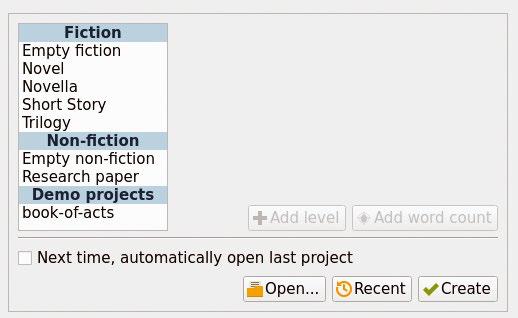
Have you ever wanted to write a novel, an essay, or anything more complex than a school report? In this tutorial, I explain a technique for organizing your writing project efficiently: the snowflake method. I'll also introduce you to Manuskript [1], a multi-platform, open source tool you can use for implementing the snowflake method for your own writing work, made to order for it. The goal of Manuskript is to help writers "create their first draft and then further refine and edit their masterpiece."
The snowflake method, which was created by Randy Ingermanson, sits in the middle between adhering to a complete, traditional outline and "freewriting," or deliberately writing without any plan, which can facilitate discovery but is also sometimes very unproductive.
Details and tips about the snowflake method are available online [2] [3], but the concept is extremely simple: Start with a really basic story summary and add little elements to it in a circular, incremental way, just like particles of ice attach to each other to form complex snowflakes. In other words, start by writing down the basic idea of the book, then the main character or characters, and then the setting using just one sentence for each entry.
Then you go back to the description and transform it into three very short paragraphs that outline the beginning, middle, and end of the story. Next you write equally short descriptions of each main character, or add minor ones, then expand the description of the setting in the same way, adding details to every description until you have all you need to actually write your story.
Installation
This story is from the {{IssueName}} edition of {{MagazineName}}.
Start your 7-day Magzter GOLD free trial to access thousands of curated premium stories, and 9,000+ magazines and newspapers.
Already a subscriber ? Sign In
This story is from the {{IssueName}} edition of {{MagazineName}}.
Start your 7-day Magzter GOLD free trial to access thousands of curated premium stories, and 9,000+ magazines and newspapers.
Already a subscriber? Sign In

MADDOG'S DOGHOUSE
Planning and community effort can help welcome Linux beginners online without precluding more advanced discussions.

Cash as Cash Can
Mike Schilli uses the YNAB tool to keep an eye on his finances. Until recently, YNAB didn't have a terminal Ul programmed in Go, but Mike delivers it here.

Innovator
Re-inventing the Ubuntu experience

Play video games natively on Linux Gaming Your Way
Bazzite, an immutable Linux distro adapted for gaming, lets you play your favorite video games on your PC, handheld, or home theater PC.

Installing mods on Steam Deck Steam Gems
The Steam Deck gaming console offers a galaxy of creative modifications for the games you love to play.

Zack's Kernel News
Chronicler Zack Brown reports on the latest news, views, dilemmas, and developments within the Linux kernel community.

System Monitoring
Mission Center, a graphical system monitor, groups all important system statuses in a compact, intuitive interface.

Exploring the Unbound DNS resolver Unbound
The Unbound DNS resolver offers comprehensive security and many other useful features.

MakerSpace
If you need to store long-term historical data, you can cobble together some Arduino modules, sensors, and displays and get them all to talk to an SQL server.

Mix It Up
Solve Bash blind spots by embedding other scripting languages into your Bash scripts to get the features you need. Pete shows you solutions for floating-point math, charting, GUIs, and hardware integration.